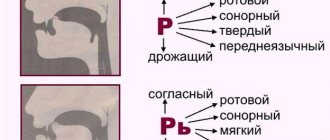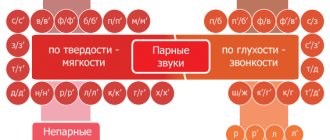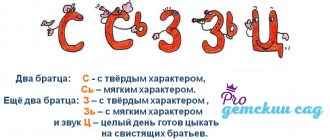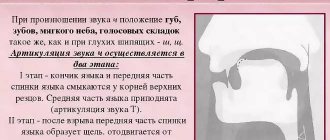Article:
Violations in the pronunciation of vibrants—the sounds “r” and “ry”—are very common.
They account for up to 26% of all sound pronunciation disorders; the guttural “r”, known as burr, is especially common. Normally, until the age of 5-6 years, children may not pronounce vibrants. But if, upon reaching this age, the child has not mastered them, parents should contact a speech therapist. If they noticed the violation even earlier, there is no need to wait 5 years - go earlier. In the article we will talk about the reasons for incorrect pronunciation of vibrants, speech therapy, games and exercises that you can do with your preschooler at home.
Reasons for incorrect pronunciation
A child may not be able to pronounce vibrant for various reasons. Let's list them:
- Anomalies of the frenulum - it may be shortened and incorrectly positioned. In some children, the hyoid ligament can be stretched with exercises. But sometimes the bridle has to be cut;
- Features of the structure of the tongue - its narrowing or enlargement (macroglossia);
- Anatomy of the jaws - a narrow upper jaw, an incorrect bite can also interfere with the pronunciation of the vibrant;
- Anomalies of the palate - with a cleft or gothic palate, vibrants are difficult to achieve;
- Incorrect location or absence of teeth in the upper jaw;
- Hearing abnormalities - in this case, the baby may not perceive vibrant by ear, an even more difficult situation is physical hearing impairment;
- Hypotonia - weak muscles are characteristic of dysarthria;
- Imitation. It often happens that a child pronounces vibrant, but comes to a children's group, where the children “burr.” And he begins to repeat after them - the skill is lost.
Its correction also depends on the cause of the speech disorder. This requires consultation with a neurologist and speech therapist. The specialist will write out a program for stage-by-stage sound production. The earlier the correction is started, the easier it is to achieve good results.
Stage 1: preparation for correctional work
It consists of identifying the sound “p” and its substitute by ear and comparing their articulation. To develop the articulatory skills that are needed to make the sound “r”, the speech therapist prescribes special exercises for the little patient - for the lips, tongue and lower jaw.
At the stage of preparation for sound production, it is necessary to introduce the baby to the parts of his language. The easiest way to show them is on the palm of your hand: tip, back, edges, tummy. This will make it easier for your baby to do the exercises.
Stage 2: setting the sound “r”
There are several approaches: staging by imitation, from other sounds, mechanically and with the help of gymnastics. Next we will look at these staging methods in more detail.
Stage 3: vibrant automation
To do this, the child pronounces syllables and words, and then more complex tongue twisters, tongue twisters, rhymes and phrases - with different stress and vowel. This allows you to bring pronunciation to automaticity.
Stage 4: introducing vibrant into speech
The final sound “r” is formed in children within 25–40 days, sometimes it takes up to 60 days. Although there are often cases when the correction continues throughout the year. You need to work with a speech therapist at least twice a week, and continue the rest of the days at home on the recommendation of a specialist.
Is it possible to practice making the sounds R and L without a speech therapist?
In the absence of other speech disorders, parents may well try to help their child cope with the difficult sounds R and L. In classes, it is important to adhere to the correct recommendations, consistency and regularity.
With due diligence - without overexertion and stress! - the result can be achieved without the help of a specialist. However, we note that if after one and a half to two months of regular classes, the child has not been able to “tame” complex sounds, you will still have to visit a speech therapist. The reason may be that you are not performing the necessary exercises correctly, or perhaps the child has some other speech disorders (for example, dysarthria, rhinolalia) that the parents were unable to identify on their own.
Drawing up a correction program
It depends on the form of the sound pronunciation disorder. For example, a child may have no vibrant in his speech at all, or he may replace it with other sounds or mix them. Rotacisms, that is, distortions, are also common. There are 8 types of rotacisms. Therefore, the speech therapist selects a step-by-step production of the sound “r” individually for each little patient. However, there is a list of exercises that are suitable for any form of vibrant pronunciation disorder.
“Imitation” technique for simple cases
The staging exercise involves auditory perception of sound. The little student is offered examples of phonemes, for example, the roar of a motor, thunder. And he, sitting in front of the mirror, repeats what he heard.
Examples of words starting with the letter "R"
#WordsWords starting with the letter “R” Cancer, hand, backpack, paradise, beltWords ending with the letter “R” Gift, fat, cheese, PR, openworkWith the letter “R” in the middle of the wordThree, cheers, aria, marriage, address, accidentWords containing several letters "R" Radar, rib, retro, furor, arthritis, cracker Countries Russia, Romania, Republic of Congo, Republic of Korea. See all countries starting with the letter “R” CitiesRome, Rivne, Rostov-on-Don, Rio de Janeiro, Riga. See all cities starting with the letter “R”AnimalsLynx, hazel grouse, crayfish, fish. See all animals starting with the letter “R” Vegetables, fruits and berries Radishes, turnips, turnips. Professions Radio operator, director, fisherman, realtor, reporter. See all professions starting with the letter “R” All names starting with the letter “R” with meanings and origins Male names Roman, Ruben, Rodion, Ruslan, Ramil, Robert. See all male names starting with the letter “R”, as well as their meaning and origin. Female names Rima, Raisa, Ruslana, Regina, Rose. See all female names starting with the letter “R”, as well as their meaning and originGymnastics for lips
The complex includes 3 exercises:
- "Let's smile!" The baby smiles, showing all his teeth. The duration of the approach is 5 seconds.
- "Tube". There are 2 variations of this exercise. The student stretches out his lips, imitating a tube, silently “reproduces” the sound “u” or closes his teeth and slightly stretches his lips forward so that a square is formed.
- "The doors are opening." The baby slowly opens his mouth so that there is a distance of 10 mm between the teeth of both jaws.
Then he smiles, showing his teeth.
Gymnastics for the tongue
To pronounce sounds correctly, you need to control your tongue muscles well. Here are the staging exercises offered to children.
"Pancakes"
The baby relaxes his tongue and places it on his lower lip. In this case, the teeth should not be covered with lips. If this variation of the exercise proves problematic, have him stick his tongue out between his lips and say “ba-ba-ba.” After this, spread the tongue again and blow until a groove is formed in the middle.
“Whose teeth are cleaner?”
The baby opens his mouth slightly and begins to “clean” the inside of his upper teeth with the tip of his tongue. Movement of the tongue - left and right.
"Cat"
The tip of the tongue bends upward. If this is problematic, suggest licking the upper teeth from the outside from left to right, and then the upper lip in the same way.
"Painter"
The baby smiles, opens his mouth and runs his tongue across the hard palate. The direction of movement is towards the teeth and away from them.
"Swing"
The exercise is performed inside the mouth. The tip of the tongue is bent alternately up and down between the teeth. At the same time, it must be gradually pulled deeper into the oral cavity.
"Horse"
The baby flicks the tip of his tongue, then sucks it to the front edge of the palate and tears it off. At the same time, he opens his mouth wide.
"Fungus"
Starting position – exercise “Smile”. The baby sucks the front part of the tongue to the hard palate, closes and opens his lips. The ligaments under the tongue become tense and mild pain should occur.
"Machine gun"
The student smiles, opens his mouth and taps the tip of his tongue on the inner surface of his upper teeth. At the same time, he clearly says “d-d-d-d.”
"Plane Sound"
Starting position - “Smile”, the tip of the tongue is located behind the upper teeth. The baby says “z” and “z” until the sound is similar to the roar of a motor.
Causes of guttural "r"
It would seem that in an environment where everyone says “r” correctly, the child should also pronounce it the same way. But this sound is insidious and difficult for children, it is not for nothing that it is most often replaced with “l”, “f” and even “d”. Why does the baby use the throat “r”?
There are different reasons. First of all - “heredity”. If one parent says the guttural “r” and the child hears it all the time, he may begin to repeat it.
A short “frenulum” under the tongue makes it inactive and prevents you from pronouncing sounds correctly. Usually this defect is removed at very different ages, but it can also be neglected.
Often the cause of the laryngeal “r” is enlarged tonsils. It is easier for a child to close the root of the tongue with the palate than to use its tip.
There are also more complex situations: nervous disorders, impaired phonemic hearing, hypotonicity of the tongue and much more. Fortunately, all this can be treated, and a defect in the throat “r” in a child can always be corrected if you contact an experienced specialist. The question is how much time and effort it will take.
If you wish, you can diagnose the causes of the laryngeal “r”, so it will be easier to deal with them. However, this is not the most important thing, since unless we are talking about serious illnesses, speech therapists use the same exercises in most cases.
Three ways to stage
Is your baby able to do articulation exercises? You can proceed to the next stage - sound production. The speech therapist has mechanical techniques in his arsenal.
- Spatula and nipple technique. The doctor places the pacifier on a wooden spatula. The student assumes the “Airplane drone” position. The specialist makes rapid movements under the tip of the tongue until it begins to vibrate. Movements - up and down, left and right. This technique is more effective if the baby's head is on the doctor's lap.
- Vibration - using paper. A wad of paper is placed on the tip of the tongue, a string is tied to it so that the paper does not fall on the floor, and it is given to the baby. He hides his tongue behind his upper teeth and tries to blow the paper off his tongue.
- Repetitions of the sound "d". The student sits in front of a mirror, opens his mouth slightly, places the tip of his tongue at the beginning of the upper teeth and quickly repeats “d-d-d-d.” Then he connects “d” with vowels: “d-d-a”, “a-d-d” and then the rest of the letters.
At this time, the specialist places a spatula under the front edge of the tongue and carries out frequent oscillatory movements. This contributes to the pronunciation of the rumble that is characteristic of vibrant.
Home correctional exercises
Where to start staging sound at home? First you need to prepare your lips and tongue using articulatory gymnastics, which you read about above. Once you have prepared the base, start staging. There are several effective ways to stage it.
From the sound "d"
Ask your son or daughter to say “d-d-d” loudly. The tip of the tongue rests heavily on the alveoli (tubercles on the roof of the mouth). You need to speak protractedly and without stopping. The tongue is pressed tightly against the tubercles. At some point, the tongue will begin to vibrate, and the baby will say “ddd-rrr.” A start!
Then you can complicate the task: add syllables in which the vibrant sounds hard: “dra”, “dru”, “dro”.
When the baby masters the skill, it’s time to introduce vibrant into speech. Move on to pronunciation of words: “dragon”, “fight”, “friendship”, etc.
Then replace the syllable “dr” with “tr”. Let the baby say the words “coward”, “throne”, etc.
The final stage is to turn off the sound “d”. Choose other words and phrases, for example: “thunder - grenade”, “ford - beard” and others.
Method of setting from the sound “zh”
If the baby pronounces “w” correctly, you can build on it. Ask your daughter or son to forcefully say “w” and at the same time move the tongue as far into the oral cavity as possible. You should get a single-stroke “r”. You need to repeat this exercise until it is fixed, and then, by analogy with the first technique, we bring it to automatism and introduce it into speech: we start from the syllable “zhr”, then “dr”, “tr” and further.
Method of setting from the sound “s”
If the baby pronounces “s” correctly, you can build on it. It is usually pronounced while exhaling, but when placing the “r” it must be pronounced while inhaling.
Ask your baby to say “sssssss,” then inhale a little through his mouth and press his tongue against the bumps on the roof of his mouth. It should look like a short "r".
The further scheme is the same as with other techniques.
Introduction of vibrant into speech
In simple cases, you can not only teach your baby to pronounce “r” on your own, but also introduce it into speech. To do this, first bring the isolated sound pronunciation to perfection. And then introduce it into speech using the following exercises:
- first the baby pronounces it in syllables;
- then pronounces it in words, with different syllables: “r” should be at the beginning, and in the middle, and at the end;
- connect stories, proverbs, phrases - this is the final stage.
Do all the exercises in the form of a game - this is how little children learn any material well. You will need imagination to captivate your son or daughter. Classes should be a joy for the little one, otherwise he will be tense and even the most effective exercise will not help achieve the desired result.
Why don't classes help?
For what reasons may difficulties arise in staging sound at home?
Firstly, the baby is not 4 years old. Before this age, it is pointless to even try to put “r”, since it simply does not exist and cannot exist - this is the pattern of speech development in children. It appears the very last. Parents, don't rush things!
Secondly, incorrect articulatory posture. Should be normal
the lips are stretched, the tongue is raised up, its tip is trembling, there is a strong directed air stream, the vocal cords are vibrating. Perhaps the baby is simply adopting an incorrect articulatory posture. If there is insufficient movement, the “r” will not give in to it.
Thirdly, improper breathing. To be able to pronounce “r”, you need a strong directed air stream that makes the tip of the tongue vibrate. If the baby does not distinguish between mouth and nasal breathing, you need to first work on this point.
Fourthly, unformed phonemic hearing. The baby may simply not yet perceive “r” by ear and, accordingly, cannot distinguish it either.
Fifthly, organic reasons. We are talking about the structural features of the facial apparatus - a short frenulum, a large or small tongue, for example. This also includes neurological disorders.
If you exercise with your baby at home, but the exercises do not produce results, consult a doctor. He will identify the cause and offer effective treatment methods for your child.
conclusions
If you notice that your preschooler has problems pronouncing “r,” contact a speech therapist. The specialist will conduct speech therapy tests, evaluate your child’s articulatory apparatus and identify the cause of the disorder in sound pronunciation. This will allow us to develop a correction program that will be effective specifically for your child.
You need to exercise regularly. As a rule, classes take place 2–3 times a week. But parents should also be involved in the process. You need to continue doing the exercises at home - then the result will not take long to arrive.
If a consultation with a neurologist or surgical intervention (for example, cutting the frenulum) is necessary, this will allow you not to waste time and quickly solve the problem.
Typically, parents of children aged 5 to 6 years turn to a speech therapist. But if you notice a problem earlier, don’t wait - go to a specialist. But you shouldn’t go earlier than 4.5 years either.
Automation of sounds R and L
It is not enough to learn to pronounce a sound separately from words, you also need to consolidate it in speech. As speech therapists say, automate it. The child must pronounce all sounds correctly, without thinking about where to place the tongue and what to do.
The following exercises are great for strengthening the pronunciation of the desired sound:
- Clear repetition of syllables with the “necessary” letter - dra-dru-dra, le-la-lo-lu-li, etc.
- Search for words starting with the required letter. Lay out pictures from children's lotto or simply open a book with bright illustrations. Ask your child to find and name objects containing the letter P or L. Watch the pronunciation.
- A little later, tongue twisters and tongue twisters will be perfect. You yourself know about Greku, who rode across the river and the grass on which firewood lay. Let us suggest a few more: “the quail hid the quails from the guys”, “the ships maneuvered and maneuvered but did not catch them”, “there are pins at the Christmas tree”, “have you washed the raspberries? They washed it, but they didn’t wash it.”
There are a lot of options for automating sounds. The main thing is to practice systematically and make sure that the child pronounces the sound correctly and clearly.







